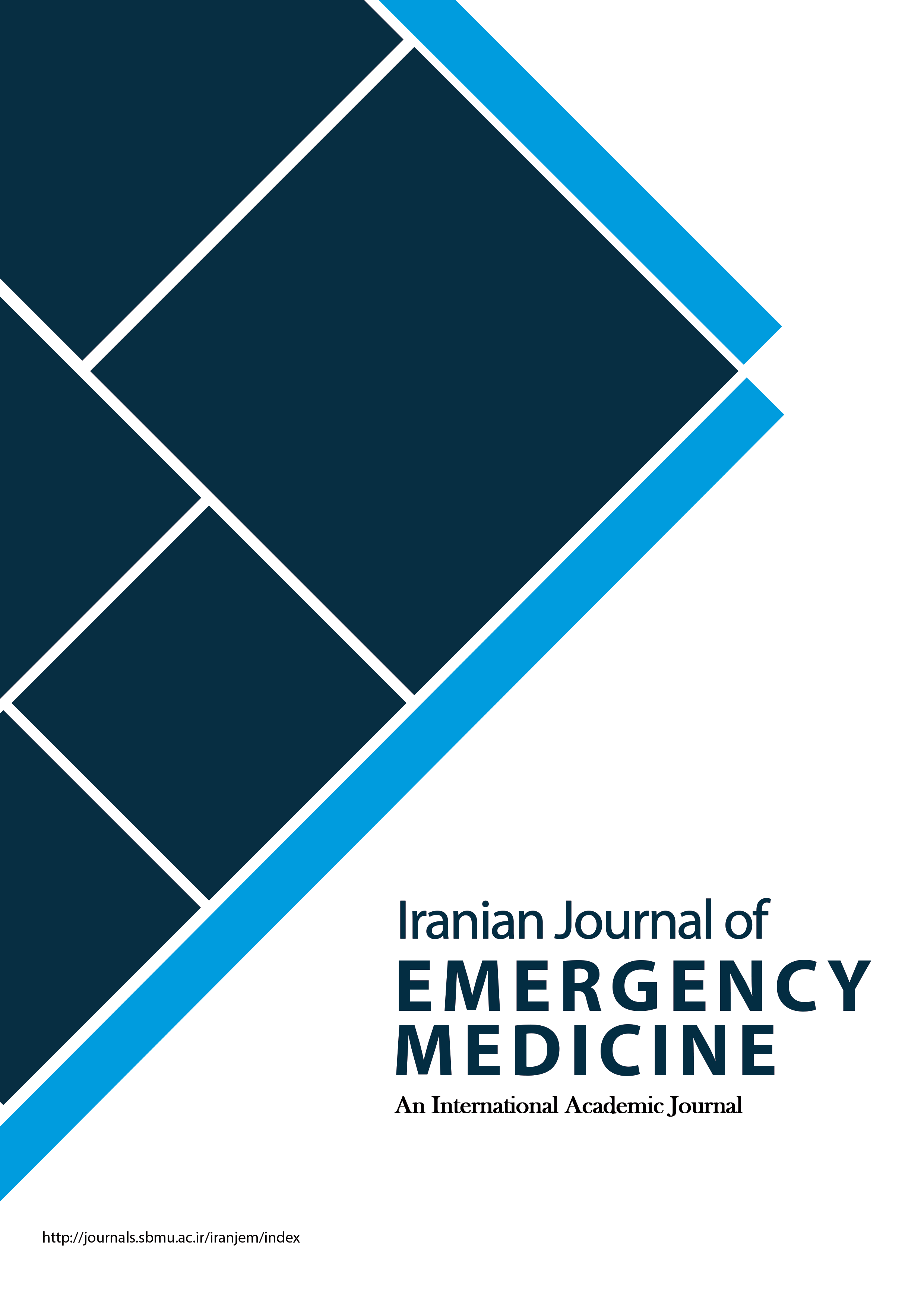Comparison of Liquid Tissue Adhesive and Suture in Pediatric Wound Repair; a Case Control study
Iranian Journal of Emergency Medicine,
Vol. 5 No. 1 (2018),
8 February 2018
,
Page e7
https://doi.org/10.22037/ijem.v2i1.18001
Abstract
Introduction: An ideal method for wound closure is one that is rapid, easy, safe, inexpensive, and pain-free with minimal infection and most importantly has minimum effect on the cosmetic issues. Therefore, this study was designed with the aim of evaluating the outcome of wound repair with liquid tissue adhesive agent and suture in pediatric traumatic wound repair. Methods: In this case-control study, 1 to 14 year-old children admitted to emergency department following traumatic injuries in need of wound closure via either suture or liquid tissue adhesive, were compared regarding speed of performance, rate of satisfaction in patient and the parents, rate of inflammation, pain and rate of wound closure on the 4th day as well as beauty results in the 6th month after wound repair. Data were analyzed via SPSS 20 and p<0.05 was considered as significance level. Results: 100 children with the mean age of 7.84 ± 3.33 years were evaluated (61% male). The 2 study groups were in the same condition regarding age, sex, and wound location; however, they were significantly different regarding wound shape (p < 0.0001), length (p = 0.037) and depth (p < 0.0001). Patient satisfaction (p < 0.0001) and parent satisfaction (p = 0.017) in addition to rate of procedure performance (p < 0.0001) were higher in cases of using adhesive. Regarding 6-month beauty outcome no significant difference was detected between the 2 groups (p = 0.463). Meanwhile, inflammation, pain and wound closure on the 4th day after repair was in better condition in the adhesive group. The results of sub-group analysis of the 2 study groups based on depth showed that the difference between the groups regarding pain (p = 0.756) and inflammation (p = 0.422) on the 4th day was not significant in cases with low depth (2-4 mm). Based on multivariate analysis, the only independent factor affecting better 4-day outcome of the patients was wound depth (p = 0.004) and in this model, closure type was removed from the final model. Conclusion: Based on the results of the present study, liquid tissue adhesive was superior to suture regarding speed of repair performance and satisfaction of the patients and the parents. Liquid tissue adhesive was accompanied by less inflammation and pain and higher probability of complete wound closure on the 4th day after repair. Regarding beauty, no significant difference was seen between the 2 mentioned methods.- ترمیم زخم؛ تروما؛ چسب مایع بافتی؛ سوچور؛ اورژانس اطفال
How to Cite
References
Singer AJ, Thode HC, Hollander JE. National trends in ED lacerations between 1992 and 2002. The American journal of emergency medicine. 2006;24(2):183-8.
Niska R, Bhuiya F, Xu J. National hospital ambulatory medical care survey: 2007 emergency department summary. Natl Health Stat Report. 2010;26(26):1-31.
Singer AJ, Hollander JE, Valentine SM, Henry MC. Association of training level and short–term cosmetic appearance of repaired lacerations. Academic Emergency Medicine. 1996;3(4):378-83.
Quinn J, Wells G, Sutcliffe T, Jarmuske M, Maw J, Stiell I, et al. A randomized trial comparing octylcyanoacrylate tissue adhesive and sutures in the management of lacerations. Jama. 1997;277(19):1527-30.
Singer AJ, Hollander JE, Quinn JV. Evaluation and management of traumatic lacerations. New England Journal of Medicine. 1997;337(16):1142-8.
Coover H, Joyner F, Shearer N, Wicker T. Chemistry and
performance of cyanoacrylate adhesives. J Soc Plast Eng. 1959;15:413-7.
Toriumi DM, Raslan WF, Friedman M, Tardy Jr ME. Variable histotoxicity of histoacryl when used in a subcutaneous site: an experimental study. The Laryngoscope. 1991;101(4 Pt 1):339-43.
MOGHAREH AA, Mirmohammadi SH. Comparison of the use of silk sutures and cyanoacrylate tissue glue after periodontal flaps in patients with moderate periodontitis. 2006.
Quinn J, Wells G, Sutcliffe T, Jarmuske M, Maw J, Stiell I, et al. Tissue adhesive versus suture wound repair at 1 year: randomized clinical trial correlating early, 3-month, and 1-year cosmetic outcome. Annals of emergency medicine. 1998;32(6):645-9.
Holger JS, Wandersee SC, Hale DB. Cosmetic outcomes of facial lacerations repaired with tissue-adhesive, absorbable, and nonabsorbable sutures. The American journal of emergency medicine. 2004;22(4):254-7.
Bruns TB, Simon HK, McLario DJ, Sullivan KM, Wood RJ, Anand K. Laceration repair using a tissue adhesive in a children's emergency department. Pediatrics. 1996;98(4):673-5.
Bruns TB, Robinson BS, Smith RJ, Kile DL, Davis TP, Sullivan KM, et al. A new tissue adhesive for laceration repair in children. The Journal of pediatrics. 1998;132(6):1067-70.
Hurley R, Murphy J, Wu C. Miller's anesthesia. 2015.
Nedelec B, Shankowsky H, Tredget E. Rating the resolving hypertrophic scar: comparison of the Vancouver Scar Scale and scar volume. Journal of Burn Care & Research. 2000;21(3):205&hyhen.
Woodward SC. Physiological and biochemical evaluation of implanted polymers. Annals of the New York Academy of Sciences. 1968;146(1):225-50.
Ellis D, Shaikh A. The ideal tissue adhesive in facial plastic and reconstructive surgery. The Journal of otolaryngology. 1990;19(1):68-72.
Quinn JV. Clinical wound evaluation. Academic Emergency Medicine. 1996;3(4):298-9.
Perron AD, Garcia JA, Hays EP, Schafermeyer R. The efficacy of cyanoacrylate-derived surgical adhesive for use in the repair of lacerations during competitive athletics. The American journal of emergency medicine. 2000;18(3):261-3.
Toriumi DM, O'grady K, Desai D, Bagal A. Use of octyl-2-cyanoacrylate for skin closure in facial plastic surgery. Plastic and reconstructive surgery. 1998;102(6):2209-19.
Quinn J, Maw J, Ramotar K, Wenckebach G, Wells G. Octylcyanoacrylate tissue adhesive versus suture wound repair in a contaminated wound model. Surgery. 1997;122(1):69-72.
Wells GA, Ducic Y, Odell PF. A Prospective Co parison of Octylcyanoacrylate Tissue Adhesive and Suture for the Closure of Head and Neck Incisions. The Journal of otolaryngology. 1997;26(1).
- Abstract Viewed: 6876 times
- PDF (فارسی) Downloaded: 1264 times
- HTML (فارسی) Downloaded: 117 times



